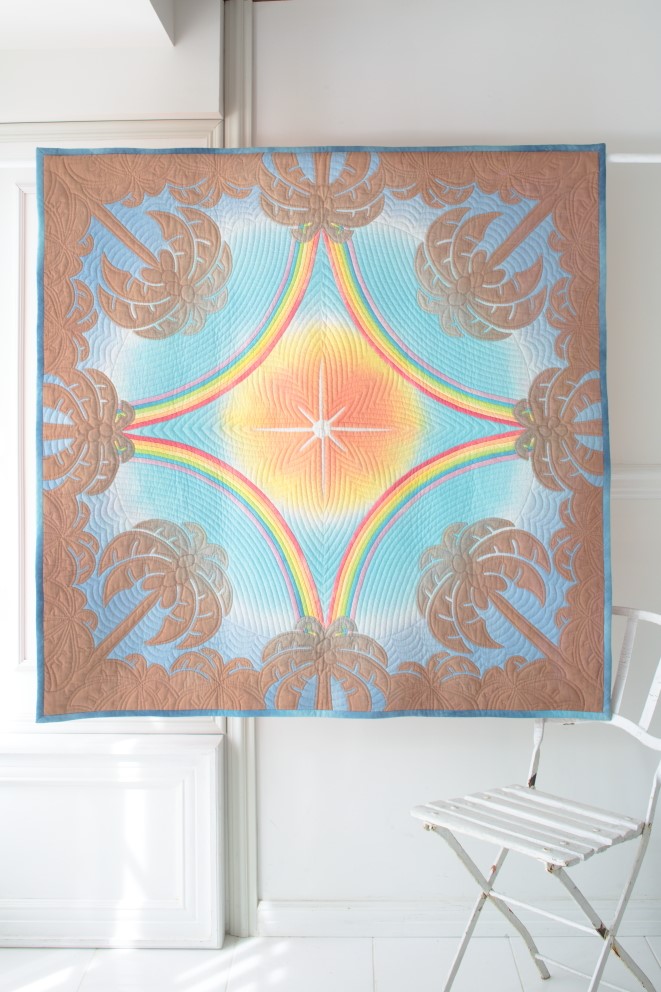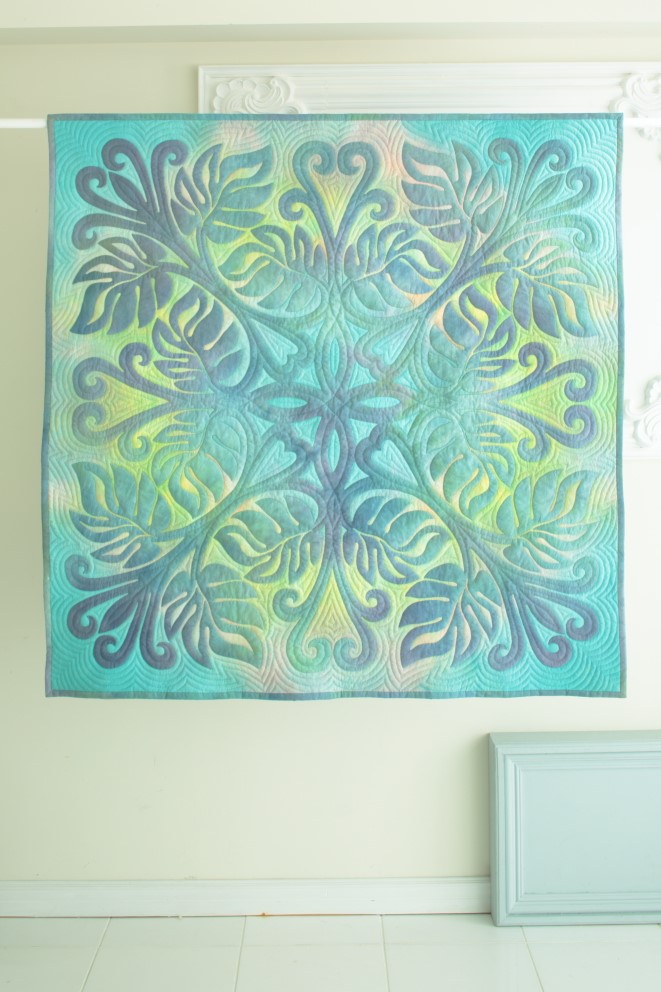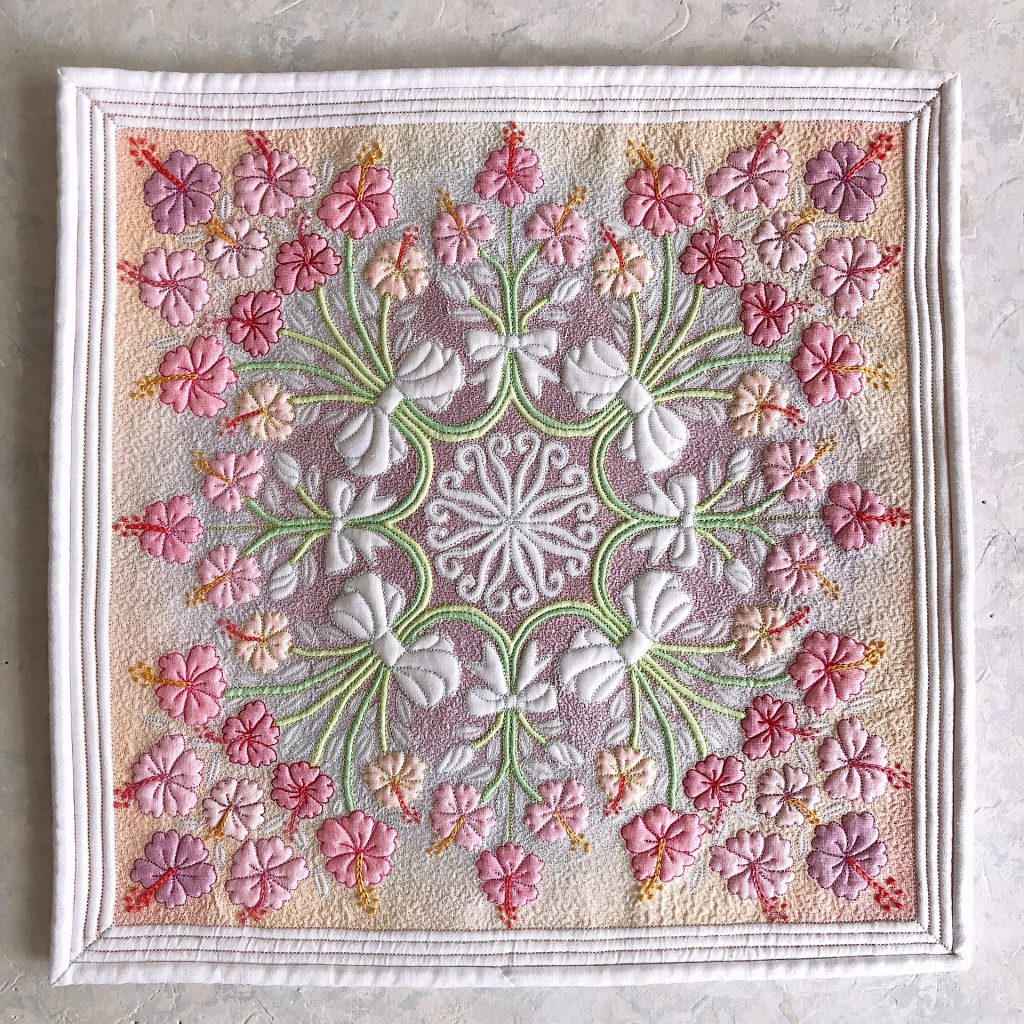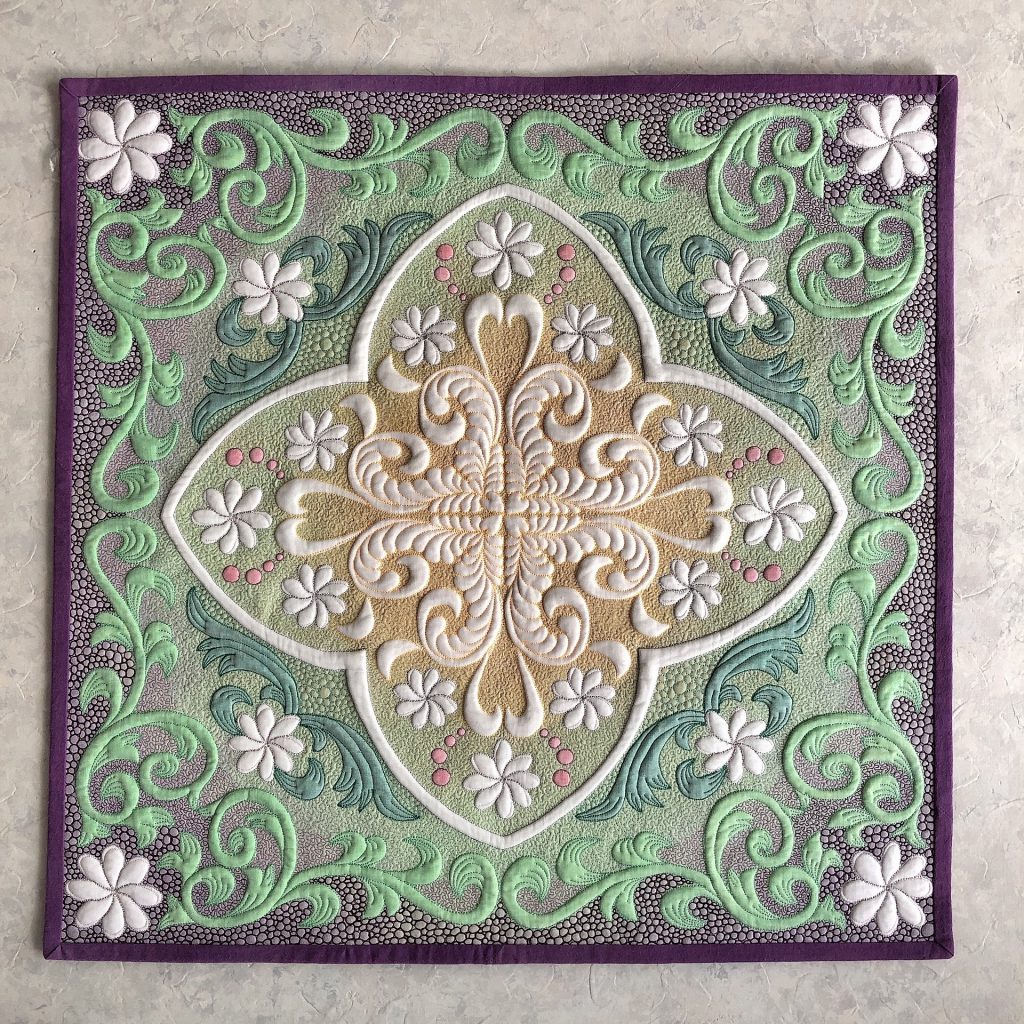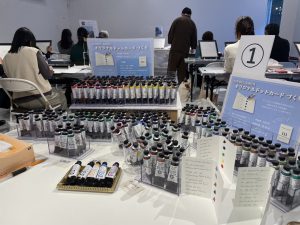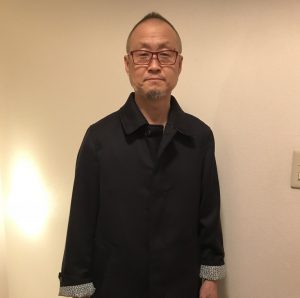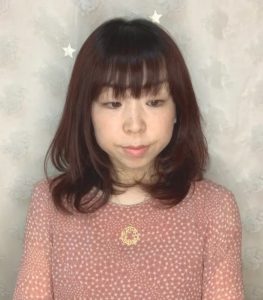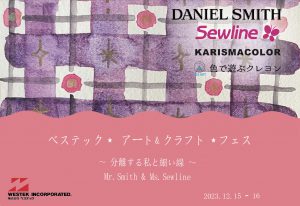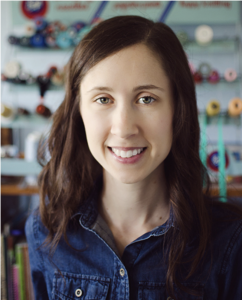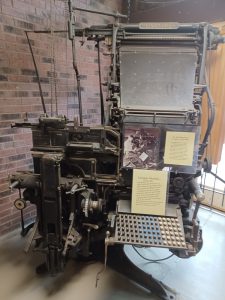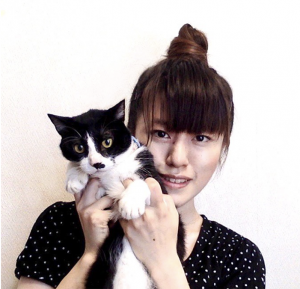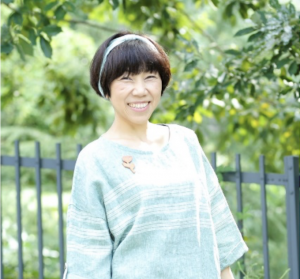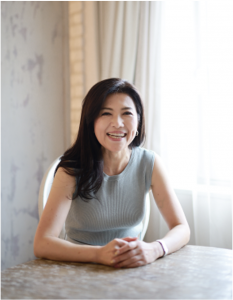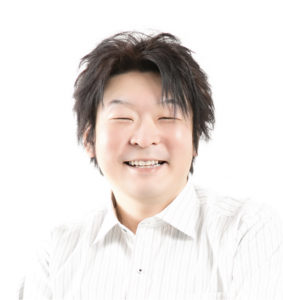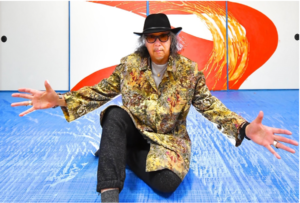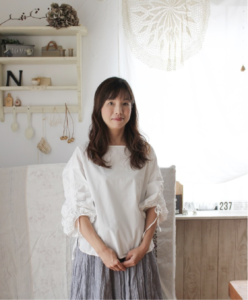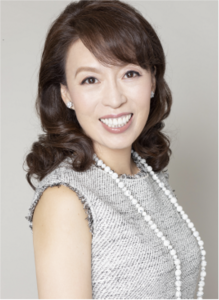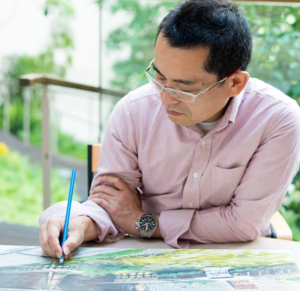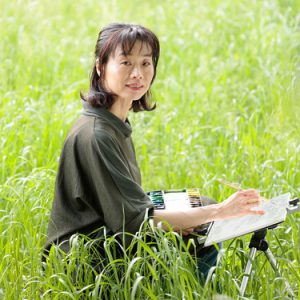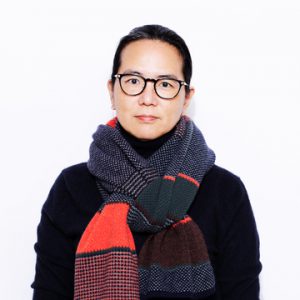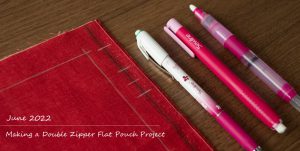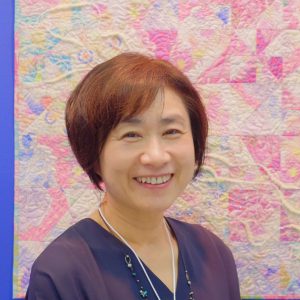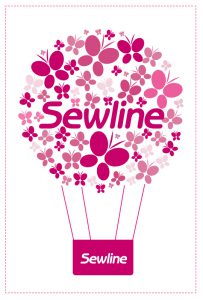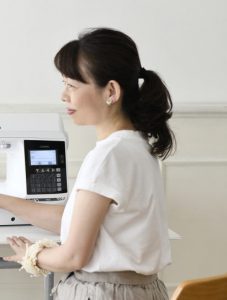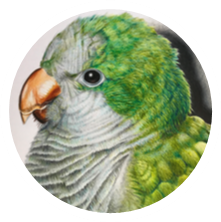#7 ゲスト:飯田 奈緒美
The Guest of December 2020 Ms. Naomi Iida
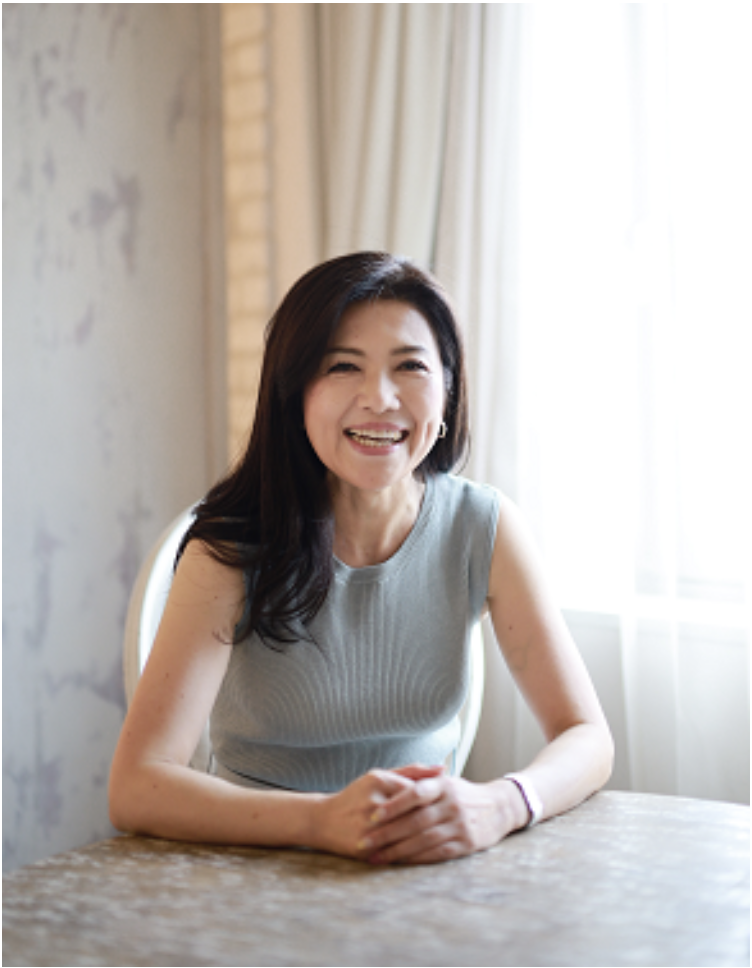
ゲスト : 飯田 奈緒美
ジャンル:ハワイアンキルト (ハワイアンキルト教室主宰)
プロフィール:
1994年から手作り小物などの展示販売をデパートなどで始める
2003年 ハワイへ行ったことをきっかけにハワイアンキルト教室に通う。
2007年 日本ハワイアンキルト協会 インストラクタークラス修了。
2011年 ハワイアンキルト教室 Puanani quilt 開催
2015年 第一回Puananiハワイアンキルト展 開催
2021年 10周年記念Puananiハワイアンキルト展開催予定
6月24日(木)~27日(日)東京芸術劇場
The Guest of December 2020 Ms. Naomi Iida
Genre: Hawaiian Quilt
Profile: From 1994, Ms. Iida started her exhibition and sale of handmade accessories and crafts at Department stores.
2003: Went to Hawaii to attend the School of Hawaiian Quilt.
2007: Completed the Instructor Class of the Japan Hawaiian Quilt Association.
2011: Opened her Hawaiian Quilt Class.
2015: Held the first Exhibition of her Puanani Hawaiian Quilt.
2021: 10th Anniversary exhibition of Puanani Hawaiian Quilt is scheduled.
June 24th (Thursday) – 27th (Sunday) at the Tokyo Metropolitan Art TheaterGallery 2 in Ikebukuro.
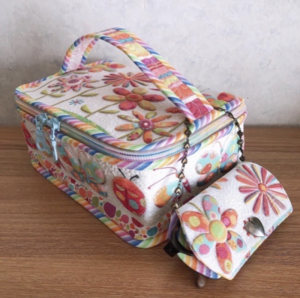
展覧会情報 Exhibition Information
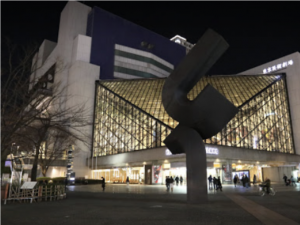
10周年記念puananiハワイアンキルト展
・日時 2021年6月24日(木)~27日(日)
・場所 東京芸術劇場 ギャラリー2
10th Anniversary of the “Puanani” Hawaiian Quilt
DATE: June 24 – 27, 2021
PLACE: Tokyo Metropolitan Theater Art Theater Gallery 2 in Ikebukuro.
インタビュー音声
The singer of the theme song : Ms. Carmella Constancio (YouTube)
Interviewer : 柴田 かおる (Kaoru K. Shibata)
Q.さまざまなご活躍をされている飯田先生ですが、先生がキルトに興味を持ったきっかけとはなんでしょうか。
キルトに興味を持ったきっかけ…というよりかは、まず最初に私が小学5、6年生だったでしょうか。
一緒に住んでいた祖母が、和裁洋裁もうなんでもやっていた人でした。その祖母が小学校高学年の私に、針を持たせてくれたのが最初だったんですね。
で、まず最初にボタン付けを教わったんです。そのボタン付けをやっていくうちに、祖母が本当ものすごく褒めてくれたんです私のことを。それが私にとって初めて自信を持てたことだったんですね。
そういうことが幼少期にありながら、大きくなって結婚して、子供を出産して、そろそろまた針を持ってみようかなと本屋さんに行ったところ、1つのキルト本を目にして…。小さい小物とかだったので、私にも出来るかな~ってことで買ってみました。
手芸は学生の頃から好きでしたので、材料的には揃っていたんですね。なので、まずは小さい生地を繋げながらのパッチワークを、本を見ながら見様見真似で子育ての合間にちょこちょこっとやっていました。
やっぱり本を見て作れるっていう…喜び?あ、これならできる!キルトって私にとって合ってる物なんだ、って気づいたのがそこだったんです。 なので、もう今から30年前とかですね。まあ本格的にキルトをやり始めたのは、もっともっと後なんですけれどもね。趣味で始めたのがとにかくきっかけでした。
Q.キルトの魅力というとなんでしょう。
今になってわかったことが、やっぱりキルトで個性を出せるっていうところ。 会わなくても作品を見ると、その人の個性が何となくわかる。色づかいであったりとか、大胆なのか繊細なのかとか、そういうところからもその人の個性を思い浮かべながら作品を見る事ができる、ってなったときに、自分もそのキルトで個性が出せたらいいなっていうところに惹かれてるのかなあ…と思います。
そうすれば、見てさえくれれば、会わなくてもその個性がちょっとわかるとか。アピールできるとか。そういうところですかね…。 日本(だけ)でキルトを見ていた時は、そんなに個性のことまで考えたことがなかったですね。ただ自分の好き嫌いで見てたくらいでした。 ただ海外に出て初めて見たのが2014年です。
2014年のアメリカヒューストンのキルトショーに行って、海外の作品を見たときに、もうものすごい衝撃を受けました。自分が見てきたキルトと、あまりにも違いすぎる。っていうのと、海外キルターさんへのイメージが、ものすごい変わったっていうところですね。
それこそ日本で私がやっていたハンドキルト。少しのものをチクチク…日本人特有のっていうのかな、繊細な?忍耐強さっていうんですかね…(笑)そういうのを感じるような作品、もうこんなちっちゃなピースをずっと繋げていくっていう…。 色もどちらかというと日本家屋に合ったような、やさしいお色づかいとかの多いキルトを見ている中で、海外に出たらほとんどのキルトがミシンだったんですね。
そして色づかいも、本当にビビットで個性的な色合わせ。こんなの日本で見たことないよねっていうキルトが、あのヒューストンの会場にズラーっと並んでた。私の見ているキルトの範囲の狭さに、本当打ちのめさ れちゃったって感じ。カルチャーショックですね。とにかく自由。こう、固まった考え方がないんだなっていうのをすごく作品に感じました。
Q.ハワイアンキルトをメインに制作されているかと思いますが、何故ハワイに関係するものがお好きなんですか?
先ほどお話ししたように、当初パッチワークを少しやっていたんですけれども、私はとにかく針を持って縫っていることが好きなんですね。
だけどパッチワークって、生地の色合わせから入るわけじゃないですか。小さいピースワーク。もうその色合わせを考える時間の方が、どんどん長くなってきちゃって…、私の大好きな“縫う”っていう作業が、本当に少なく感じてきちゃったんです。それって段々「私に合ってるのかな?」っていうところがありまして…。
そう思っていた時に、友達が「ハワイに行きたい」と。それで私はその話に乗りました。で本当にその、ハワイに着いた途端、なんなんだろうな空気が違うっていうところから、突然ハワイが好きになったっていう。何にも知らないのにハワイが好きになった。
で!そういえばハワイアンキルトってあったな、同じ
キルトでも。どういうものなんだろうってハワイのお店とかを見て、こういう感じなんだって。こう言ったらなんですけど、単純なんですね、ハワイアンキルトって。とっても大らかなキルトです!もしかしたら、私はこっちの方が合ってるのかもしれない。もう最初にたった2色の生地を合わせれば、ずっと縫ってられる。っていうことで、「あ、もう私これしかない」と。
で、もう帰国後すぐに教えてくれる教室を探しました。ちゃんと段階のある、本当は好きでなかったはずのカリキュラムがあるところにドンと入り、一応インストラクターまで修得して…ってやってる間に、このハワイアンキルトなら、全ての物が習得できたかもしれない。これからも活かせるかもしれない…ってそこからすっごくハワイアンキルトにのめり込みましたね。
Q.ブログの方で拝見させて頂いたソーイングボックスがとても素敵でした。あれはキルトでありながら小物を作られているんですね。
ありがとうございます!
そうです。ハワイアンキルトって元々ね、ベッドカバーですとかタペストリーですとか、クッションカバーで、小物という部門で日本で広がったのは、やはりキャシーさんのおかげですかね。
やっぱり日本人は実用性のあるものが好きだと思うんですね。もう今ではいろんな方がいろんな工夫をして作ってらっしゃる。
そんな中で私はハワイアンキルトをお教室を持って教えています。本当に今となっては、生徒さんにハワイアンキルトの私の持っている手法を全て教える、っていうことと、生徒さんにデザインを提供する。もうそれが大きな役割だと思っています。
その2014年にヒューストンに行き、それをきっかけに今度はミシンキルトにも興味を持ったり、コンテストにも興味を持ったりしてきました。
で、そのコンテストに興味を持ったのは、まずは小さなサイズで作れるミニチュアっていうすっごい単純なところですよね(笑)単純なところからミニチュアを…、ただミシンいきなりはできないので、ひたすらハンドで。ちっちゃくちっちゃく…っていうのを3年くらい続けたと思います。
でも海外のミニチュアキルトを見ていると、本っ当に細かいんですね…。本当に繊細で細かいんですね。とてもハンドでは追いつけない細かさだったんです。ミシンの方が本当に細かいことができる、っていうことに気づき。そこからミシンに切り替え…ミシンキルト、ミニチュアキルトをコンテストに出し始めるっていうのがスタートしましたね。
で、そのミシンキルトをやったからこそ、見て頂いた小物…。
ーああ、そうなんですか!
そうなんです!あの材料はほぼアメリカで入手してきた材料で作ってます。USAコットンは元々大好きだったんですけど、中々ハワイアンキルトでUSAコットンって、使うといっても裏生地ぐらいなので、大して活躍はできなかったんですけど…。まあそんな感じで、アメリカのコットン生地を毎年選びに行くのが本当に楽しみでしたね~。で、これが最後の最後、去年のヒューストンで購入してきた生地ですかね。
日本で売られている中綿があるんですけど…その中綿を挟んでキルティングっていう作業をミシンでしていくんですけど、やはり日本ではない中綿がアメリカでは出てまして。で、それも一緒に購入してきて、そうだ!っていうことで制作したのがこの作品でした。
こういう小物づくりも本当に大好きですね。
Q.そういったデザインを考えるときは、その物のデザインか、布を見てデザインするのかどっちなんでしょうか。
な、なんでしょうね…。もう全てインスピレーションなんですね、って言ったら何か全て終わっちゃうんですけど!(笑)本当直感というかひらめきというか…。
今回の場合は“ミシンキルト用のソーイングボックスを作りたいな”から始まり、じゃあ布は何にしよう。布は自分の好みのものっていうのは全て買い溜めている感じなんですね。作りたいときに材料がないのが1番モチベーション下がってしまうので…。それで選ぶ。そこから自分でサイズを決める。
あんまり出来上がりを最初から全て設計して…って始めるタイプではなくて、このくらいのサイズにしましょう、じゃあチョキチョキ布切ってミシンかけて…、ちょっと縮まっちゃったからじゃあこれくらい小さくしましょう、ってどんどんカスタマイズして出来たのがコレっていう感じです。
なんかいつもそんな感じになっちゃいますね!計画性がない…とも言いますね(笑)
ハワイアンキルトのデザインもそんなことが多いです。
Q.色々とお話し伺っていると、やはり縫っている時が1番楽しいですか。
そうですね。縫っている時が1番楽しい……あー、でもそれもその時によって違うんですね。
例えばハワイアンキルトで、生徒さんからデザインを頼まれました。それでデザインをします。ハワイアンキルトの特徴である8分の1のデザインですとか、4分の1のデザインですとか、1つのパーツにデザインしたものを、上下左右対称に広げていくものなんですね。なので、こんな少しのスペースにデザインをしていけば良いんです。
なのでカンタンなんですが、それを開いた時に果たしてどういう形になるのかっていうのは、もう生徒さんに試してもらっちゃうっていう(笑)そんな段階がありまして…なので生徒さんがカットして、それを全部広げて初めて全容がわかるっていう。その時が1番ドキドキワクワクする時間です。
―その時に、何かテーマを持ってデザインをされますか?例えば“海”とか“空”とか…
ハワイアンキルトは、南国の植物をモチーフにしているんですね。植物+ドルフィンですとか、ウミガメで
すとかサンゴ…みたいに植物とはちょっと違ったものも入ったりしていますけど、大体そうやって単体で(生徒さんからは)リクエストされることが多いですね。
例えばハイビスカスのデザインでお願いします、とかパイナップルでお願いします、思いっきりごっちゃごちゃでお願いしますとか。そういう風に、生徒さんのリクエストに全てお応えしてます。なのでテーマといったら、もうそれだけなんです。ハイビスカスだったらハイビスカス。
風景の中に何、とかっていう、あまり深いことはないですね。
―なるほど、じゃあ結構わかりやすいといえばわかりやすいですね。
わかりやすいです!説明しないとわからないっていうテーマのものは、ほとんどないかもしれませんね。私の場合は(笑)
もう見たらわかるっていう感じですかね。単純です!
Q.海外の様々なキルトショーでもご活躍されておりますが、海外に向けてどのようなことを意識して作品づくりを行っていますか。
特に…、特に意識をしていることというのはないんですけれども…。
海外のキルターさんは、とても色づかいですとか、モチーフの組み合わせですとか本当個性豊かな、とにかく自由な発想でされてるっていうのが私のイメージなので…。じゃあ日本人キルターの良さは何だろうっていったら、やっぱり繊細なことができるというところなのかなと。
やっぱりアメリカで、ハンドの(日本人)キルターさ
んが毎年入賞なさっているように、会場で「私は日本人」って言うだけで「日本人のキルターさん素晴らしいね!」ってとにかく褒めてもらえるのは、どういうところで言われているんだろうなっていうのを考えたら、やはり日本人が持っている繊細さ。それをキルトに表現すること。キルトに組み入れていくことなのかなって思うんですね。
表現の仕方って色々あると思うんですけど、例えば日本なら富士山ですとか桜ですとか…そういうモチーフにしてっていう表現の仕方もあると思うんですけど。私はどうしてもモチーフ、というか流れは全てやっぱり南国の植物がテーマで、ミニチュアキルトも作っているんですね。なので、そういう和的なものはちょっと置いといて、技術に精細さ、得意とする工夫…他人と同じでないようなキルトを作る、とかっていうことを心掛けるようには作ってます。
ーそれは今後の活動としてもやっていきたいということで…?
そうですね。コンテストに関しては国内外のキルトコンテストに、自分の一作を見てもらう…うーん、なんでしょうね。1人でも多くの人に見てもらえると嬉しいなっていうことで、出来る限りチャレンジしていきたいと思っています。
Q.今後の活動について伝えたい情報などがあればお願いします。
おかげさまで来年の4月で、お教室が10周年を迎えます。で、10周年の記念キルト展を6月に行います。
Qどういうものを展示なさるんですか?
生徒さんの今までの作品…展示会場が池袋の東京芸術
劇場という場所で、ギャラリーを使って行うんですけれども、そこには全部壁面が本当たくさんあるんですね。その壁面を十分活かせるような、やはりタペストリーですね。ウォールハンギングですか。その1mちょっとくらいのものをズラーッと生徒さんのものを並べて、あとは私の今まで作ったハワイアンキルト、そして趣味であるミニチュアキルトを今まで作ってきたもの全てを展示させてもらおうと思ってます。
とにかく、まあコロナなのでどうしようと思っていますが…、ハワイアンキルトに限らず、手芸全般って感じかな」「ミシンを動かしてみようかな」ってそういうちょっとした場が作れたらいいなと、本当にちっぽけですけど思っています。
色々な分野の手芸の先生にお声掛けをして、ちょっとしたスペースでワークショップを毎日行おうと思っているんですね。
キルトの世界だと特に、若者がキルトに入ってきてくれる、興味を持ってきてくれるっていうのが、すごく少なくなってきてると思うんです。とっかかりとしてまずは手芸から、みたいなところで、展示した作品を見てもらって…「キルトやってみようとか「ミシンを動かしてみようかな」ってそういうちょっとした場が作れたらいいなと、本当にちっぽけですけど思っています。
Q. Ms. Iida, you have been active in various fields. What made you interested in creating Quilts?
First, when I was in the 5th or 6th grade of elementary school, my grandmother who lived with me, was a person who was doing everything in Japanese dressmaking! She did sewing on cloth and also kimono. It was the first time that my grandmother gave me a sewing needle in the upper grades of elementary school. It was the first time for me to have some interests in sewing when she taught me how to put on a button. By doing that she praised me a lot and it encouraged me so much to have confidence. When I grew up, I got married, had a child and after that had some free time! I went to a bookstore to take up the needle and sewing again. When I went to the bookshop, I saw one quilt book. It was a small accessory, so I thought I could do it, so I bought it! I’ve liked hand crafting since I was student, so I had all the materials such as fabrics. I started to do patch work with the small fabrics by learning from the book and imitating the appearance – – in between caring for my children. At that time, I found much joy in making quilts because it was not so difficult for me through the instruction of books. Quilting fit my taste and character. That’s when I realized quilts are the right thing for me! Now it has been 30 years since then. Of course, I started doing quilting in earnest even later; but it started as my hobby.
Q. What is your personal appeal in quilts?
What I’ve learned now is that quilts can express personality. I found that it was to express the character of each person. Even if I have not met the person who made the quilt, I understand the character of the creator from the use of color and fabrics. When I see the quilt, I can imagine that he or she is more daring, bold or delicate. It brings out the individuality of the quilt maker. Then, I recognized that I was so attracted by the quilt, which expresses our character very much. Then, people can understand my character by looking at my work. You can understand the individuality without meeting and it can appeal to the people. It is a creative place. When I was looking at quilts in Japan (only), I had never thought about individuality. I just looked at what I liked or didn’t like. However, it was 2014 when I saw the individual character of the creator for the first time when I went abroad. If I did not look at the quilts overseas, I would not have thought about the character of the creator in their works. When I went to the 2014 Houston, Texas Quilt Show in the United States and saw these overseas works, I was already shocked! It’s too different from the quilts that I have seen. The images of the overseas quilters changed tremendously. When I saw their works, it really impacted me since the works are quite different from ours (including the ones I have seen in Japan.) My image of the quilters of overseas has changed a lot. You know, the Japanese quilt is hand sewing and it needs delicate attention and lots of patience to sew tiny pieces to connect them. The colors are also different. Ours are more soft colors to be matched to the Japanese house. When I saw the quilts in the USA, most of those are made by sewing machine. The colors are much more vivid with unique color combinations. Quilts like this, I have never seen in Japan all displayed and lined up at a venue like in Houston, Texas USA. I was so overwhelmed by the scope of quilts I saw. That was culture shock. I was so impressed by the freedom, no fixed way of thinking in their work.
Q. You are making mainly Hawaiian Quilts. Why do you like the things related to Hawaii?
As I mentioned earlier, I was doing a little patchwork at first, but I just like to sew with needles. However, patch work needs to start with color coordination and requires more time to think about the colors, while my favorite process of actually sewing became less and less. There was a place where I was gradually asking myself, “Is this right for me?”When I thought so, my friend said, “I want to go to Hawaii,” so I agreed to her proposal! As soon as I arrived in Hawaii, I sensed a different atmosphere and suddenly I fell in love with Hawaii. Even though I did not know anything about Hawaii, I just liked it. Then, it comes up in my mind… There are Hawaiian Quilts. I was so curious and thinking of it. Then, I went to the shop to see it. It looked really simple and an easy quilt to make. I thought that maybe I’m better off here? With two color combinations, I can continue to sew… Yes, it is quite right for me. After returning to Japan, I searched for a classroom that would teach me Hawaiian quilting and went there. There was curriculum there, which I did not really like, but I learned a lot and got the certification as an instructor. During that time of learning, I thought that I obtained every technique and that it would be useful for my future… Then, I was really absorbed in the Hawaiian Quilt from there!
Q. The sewing box I saw on your blog was very nice. It looks really beautiful. That is quilting, but not the wall hanging type. It is a small box but, it was really chic.
Thank you so much. That’s right! Yes, Hawaiian quilts were originally for the bed cover, tapestries and cushion covers. And, it was thanks to Ms. Cathy Nakajima, Hawaiian Quilts spread in Japan in the accessory category! For Japanese people, we like the useful practical things. Nowadays, many people are making many things with lots of ingenuity. Among them, I have the class and teach the people how to make the Hawaiian Quilts. I think that it is my big role to teach the students all of the techniques I have of Hawaiian Quilts and provide for them my design, too. I went to Houston, Texas USA in 2014, and this time I became interested in sewing machine quilts and contests. So, I was interested in the contest because it’s a very simple thing that you can make a miniature in a small size (laughs)! That is why I created by hand sewing for approximately 3 years. But, when I looked at the overseas miniature quilts, it’s really fine. It’s really delicate and detailed. It was so fine that I couldn’t catch up just by hand. I realized that the sewing machine can really do fine work. But, it was hard to start with a sewing machine from the beginning. It is not possible to do such a thing by hand sewing. From there, I switched to a sewing machine. I started to enter my sewing machine quilts and miniature quilts into the contests. With the experience of making machine quilts, I was able to make the accessory sewing box you saw in my blog.
-Wow, oh that’s it!
That’s Right! Yes, most of materials are obtained in the USA. Of course, I love USA cotton fabrics, but we do not use the USA cottons for Hawaiian Quilts. Mostly, we use USA cottons for the back side as a lining fabric. After that, I really looked forward to going to Houston to select those fabrics very much. That box was made by the materials I bought in Houston last year. There is some batting, which is available in Japan and we put the batting in between and arrange the quilting by sewing machine. In USA, however, I found the batting, which is not available in Japan and bought it. I used this for this sewing box. I really love making small items/accessories like this!
Q. When you design such a small article, how do you come up with the idea? By the fabrics you selected or the design itself?
Well – – It is all my inspirations. Really, it is inspiration and by the intuition. In case of that sewing box, I really wanted to make the sewing box for sewing machine quilts, so what should I do with the cloth? Then, I looked for the fabrics. I have the stocks of my all favorite fabrics. Since it would be quite disappointing if I found there were no materials. Then, I selected the fabrics and decided the size dimensions. I am not the type to lay-out from the beginning. It’s not the type of project that starts by designing everything from the beginning, but instead…let’s make it this size, then cut the cloth and sew it on the sewing machine. Just cut the fabrics and sew. If the size is a little bit small, then, I change the size again and gradually customize to make it. It’s always like that! I also say that there is no plan (smile & laughs). Hawaiian Quilt designs are often like that!
Q. Having heard your story, is it the most fun and enjoyment when you are sewing?
Yes, I really enjoy my time most by sewing. But, it totally depends on the time. For example, I was asked by a student to make the design of a Hawaiian Quilt. You know, the Hawaiian Quilt has the design of 1/8, 1/4 pattern. One pattern design is to be expanded symmetrically in the vertical and horizontal directions. Therefore, designs can be done in such a small space. It was quite simple. Therefore, I asked the student to cut the piece and put it. Then, when it is opened, it is a dramatic show time reveal to really find out what it will actually look like. It is said that the whole picture can only be understood by expanding it. That is the most exciting time for all of us.
Q. At the time of creating, do you design with a theme such as the ocean or the sky… when you begin to design the quilt?
The Hawaiian Quilt has a tropical plant as the motif. There are things that are a little different from plants, such as plants and dolphins, sea turtles, corals, etc., but in general they are often requested by themselves (from the students). It is most likely that my students request me to design with one article. For example, please design a hibiscus or pineapple. Or please put everything as many as possible. In that way, we respond to all students requests. So that’s all there is to it! When you say theme, it is very easy and clear. It is a hibiscus. There isn’t a depth of theme within the landscape.
Q. I see! Then it is easy to understand!
Yes, it is quite clear. There are no difficult themes, which require explanations, in my case… (smiles & laughs)!Just see – – and you got my theme. It is quite simple.
Q. You are also active in various quilt shows overseas. (Outside Japan) What kind of things do you keep in mind when creating your work for overseas? And contests?
There is nothing special for me to think of. My image is that overseas quilters are very colorful, have a combination of motifs, and are truly unique, with free ideas. They have quite a free spirit to make the quilt… That is my image. Then what are the different features of the Japanese quilters?I wonder if they can create with the Japanese delicate and fine techniques. Every year, Japanese hand quilters are wining some prizes in the USA contests. When I was in the Houston show, it was said that Japanese quilters are wonderful. I was so happy and thought that our Japanese delicacy would be very admirable from other countries. Then, it is my role to incorporate such unique Japanese originality and technique into my quilt. I believe that there are many ways to express it. For example, if we put the image of Japan, it would be Mt. Fuji and cherry blossoms. But, for me it is not. The flow of my theme is all about tropical plants, and I also make miniature quilts. Therefore, I am trying to keep that kind of Japanese image aside and I would like to make a quilt which is not the same as others, while using the Japanese fine techniques and my ingenuity.
Q. Is that part of your future activities?
Yes, I would like to challenge the contests in Japan and also other countries to see my work… and I would be happy if as many people as possible could see it. So I would like to take on challenges as much as possible.
Q. Do you have any upcoming news or information about your future activities that you could share?
Thanks to you, the classroom will celebrate its 10th Anniversary of my class “Puanani” in April next year. So we will hold a 10th Anniversary Quilt Exhibition in June!
Q. What kind of creations will you be presenting at the exhibition?
The works of my students… The exhibition venue will be the Tokyo Metropolitan Art Theater in Ikebukuro. We will use the gallery and there are so many walls. We can utilize such a wall with the tapestry that they made. The works will make full use of the wall surface. It will be wall hanging types and the size would be 1M. Along with my students’ works, I’m going to display the Hawaiian Quilts that I’ve made so far, including all the miniature quilts I’ve created by arranging them about 1M from the students.
Of course, we are not sure if we can do workshops because of the current health situation. But, I would like to ask some teachers (in various fields) of hand crafts to have workshops during the exhibition period.
In the Quilting category, it seems the number of young people interested in that category is decreasing. Therefore, interest can begin from the hand crafts. As a starting point, I would like to see the exhibited works in places like hand crafts to say, “Let’s try Quilting” and “Let’s use a sewing machine.” I wish I could create a little place like that.
I would be very happy if they become interested in sewing machines and quilting. This is very small thing…but, that is my hope.
これからもいろいろな分野での第一人者の方、新進気鋭の芸術家の方、ファッション、いろいろな分野の方たちのインタビューを配信させていただきます。
We will continue to deliver compelling interviews with the leading creative artists and influencers in various fields such as art, fashion, cooking, etc…
We hope you’ll be looking forward to many more exciting and interesting creative updates soon!
